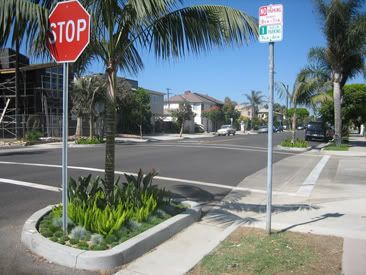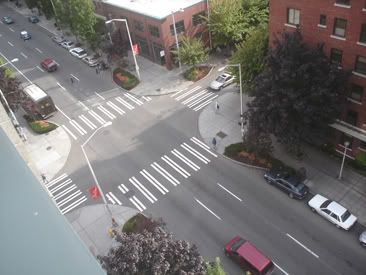
For those interested in promoting a pedestrian environment in Southern California, there is a tendency to focus on the negative, but even in the land of cars there is reason for hope. As stated in an earlier article, examples of pedestrian-friendly elements in Long Beach already exist. Along a couple major commercial corridors, the city and local Business Improvement Districts (BIDs) have taken the initiative to focus on improving walkers’ experience. 2nd Street in Belmont Shore and Pine Avenue downtown have a number of design elements that enhance the pedestrian environment, including shade-making street trees, sidewalk paving patterns, outdoor dining opportunities, and street furniture such as benches, trash receptacles, and newspaper racks.
A few other commercial areas have some subset of these features too, but on Pine Avenue and along 2nd Street we find the further step of expanding the pedestrian area with what are called “curb extensions.” Curb extensions, also known as “sidewalk bulb-outs,” are one of the most effective methods to improve pedestrian safety and comfort. The Federal Highway Administration defines curb extensions as a section of sidewalk at an intersection or mid-block crossing that reduces the crossing width for pedestrians and that can help reduce traffic speeds. Curb extensions reduce the distance one must traverse when crossing an intersection, typically by around fifteen feet. The reduced crossing distance (and thus faster crossing time) promotes better pedestrian traffic flow.
While curb extensions are ideal tools for promoting pedestrian activity, they are often opposed by traffic engineers because they remove the opportunity to create a right-turn lane for automobiles. This forces right-turning traffic to share a lane with traffic moving forward through an intersection. The impact on this forward-traveling car traffic is greater, because while waiting for crossing pedestrians, a right-turning car effectively blocks the lane for cars wishing to move forward. In cases where a major thoroughfare is crossed by smaller, secondary streets, some traffic engineers offer the compromise of building the curb extension so that it takes up space only on the secondary streets, leaving the thoroughfare untouched. For instance, that is why the sidewalk only extends into the smaller streets that intersect the thoroughfares of 2nd Street and don’t extend into Broadway and Third Street at Pine Avenue.
However, most who emphasize pedestrian needs will advocate for curb extensions on all four corners of an intersection. In other words, they will support the idea of curb extensions into a thoroughfare, stating that it is more important for pedestrians to cross the busier street. In fact, the shorter distance that results when there is a curb extension on each side of a street means that the average pedestrian spends at least four seconds less time when crossing the street (based on Manual on Uniform Traffic Control Devices of average walking speed of 4 ft./sec.). The irony is that the reduced time necessary for walkers to cross the street can provide more time for cars to pass, partially compensating for the loss of a right-turn lane. In other words, everybody wins: cars get maintained traffic flow and pedestrians get safer crossings.
The introduction of these curb extensions or “bulb-outs” can give heartburn to the staff of public works departments, because the affected intersection often needs to be regraded for drainage purposes. One way to avoid the necessity of regrading is to add a drain through the curb extension, thereby allowing the water to travel along the line of the existing gutter. Unfortunately, this often requires maintenance to avoid obstructions in the bypass drain. In Seal Beach (California), as well as other cities, public works departments create open troughs between the existing sidewalk and the extension, reducing potential obstructions as well as easing maintenance. The City of Portland is building new green curb extensions that while avoiding troughs or drains also addresses urban storm water management in an environmentally progressive way.

One of Seal Beach’s new “open trough” sidewalks.
When implemented properly, curb extensions provide additional safety benefits for automobiles and pedestrians alike. Expanding portions of the sidewalk into the intersection reduces the opportunity for visual obstructions at the corner, while allowing traffic to safely pull further forward without being exposed to perpendicular traffic. This allows for better visual connection between drivers as well as pedestrians. As a traffic calming tool, the encroachment of the sidewalk toward the street can make drivers more aware of pedestrians, convincing them to slow down and drive more cautiously, especially at intersections.
As in the case of Long Beach, curb extensions are popular design tools for enhancing the pedestrian experience along commercial main streets. However, a growing number cities are now building them on a more substantial scale. Cities like Davis and Pasadena are placing them not only in commercial areas but within both urban and single-family residential neighborhoods. These cities are discovering a range of additional advantages, from pedestrian safety to neighborhood beautification. Curb extensions can offer additional landscaping opportunities and provide attractive gateways into residential neighborhoods. The city of Seattle has adopted them as one tool in their Neighborhood Traffic Control Program, which also includes roundabouts, chicanes (curves along a street), and speeding monitors.

An example of Seattle’s new intersections.
Using tools like these, many cities have thus created distinctly more intimate neighborhoods: a sea of black top asphalt can be replaced with mature landscaping that can accommodate moving and parked cars while providing ample space for pedestrians. Curb extensions, when introduced on a wide scale both in commercial districts and in residential communities, can help to transform the collective psychology toward the street from a place solely for moving cars to a more integrated urban geography, one that moves our various mobility options as well as improves the city’s open space network.
